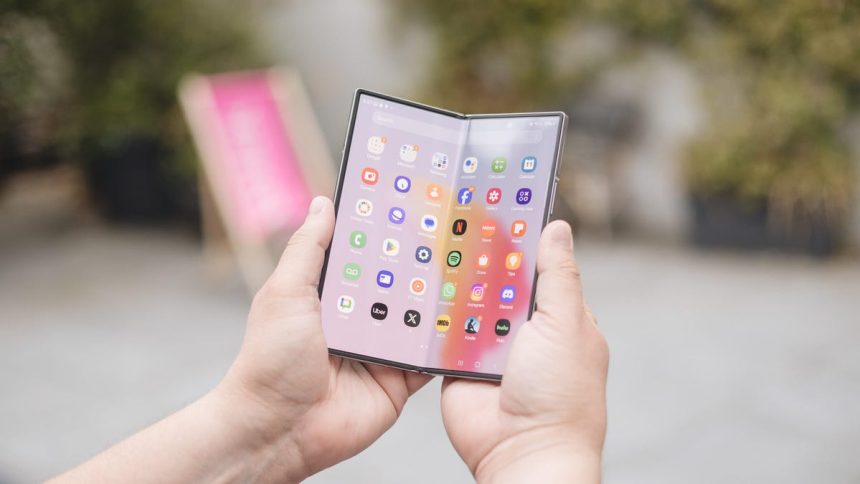Samsung’s latest flagship foldable compared to OnePlus’ first foldable effort: let the showdown begin.

For years, Samsung held the crown as king of foldables nearly by default for its annual releases of the Z Fold and Z Flip models, but recent contenders have come out to challenge the company for the folding phone throne. Here’s how the latest Samsung Z Fold 6 compares versus the OnePlus Open that came out earlier in 2024.
The Galaxy Z Fold 6 has foldable lineage that’s the culmination of years of refinement; in the other corner, the OnePlus Open goes for conventional book-style design and functionality as the phonemaker makes a bold play in the niche. While we haven’t had time to review Samsung’s latest foldable, CNET Senior Editor Eli Blumenthal had sound thoughts on the OnePlus Open as a great first effort still limited by its software and compromises.

OnePlus Open
OnePlus/CNETBut all of Samsung’s refinements come at a literal price, as the Z Fold 6 starts at $1,900, a $100 hike from last year’s Z Fold. The OnePlus Open starts at $1,700. While price isn’t everything, there’s a sizable gap between the two models.
Otherwise, the two foldables are pretty similar. Both have cover displays that are virtually identical in size with the same maximum 120Hz refresh rate: the Galaxy Fold 6 has a 6.3-inch AMOLED (2,375 x 968 pixel) display, while the OnePlus Open’s 6.31-inch OLED (2,484 x 1,116 pixel) screen is slightly sharper due to a higher pixel density.

Samsung Galaxy Z Fold 6 shown during the Galaxy Unpacked presentation.
Samsung/Screenshot by James Martin/CNETLikewise, when unfolded both devices have roughly similar internal screens with a maximum 120Hz refresh rate. The Z Fold 6 has a 7.6-inch (2,160 x 1,856 pixel) AMOLED display while the OnePlus Open has a slightly larger 7.82-inch OLED (2,440 x 2,268 pixel) screen that’s again sharper with more pixels to spare.
Given its slightly wider internal display, it makes sense that the OnePlus Open is overall just a bit wider than the Z Fold 6 in design. The OnePlus foldable is only rated IPX4 to resist splashes of water rather than complete immersion, while the Z Fold 6’s IP48 rating means it should survive being dunked in knee-deep water for up to 30 minutes, as well as survive some dust and dirt exposure.
As far as cameras, the OnePlus Open’s shooter suite has higher megapixels, but Blumenthal preferred the detail and sharpness in the then-comparable Samsung Galaxy Z Fold 5, even if he applauded its 120x zoom capabilities. The OnePlus Open has a 48-megapixel main camera, 48-megapixel ultrawide and 64-megapixel 6x optical zoom telephoto camera. The Z Fold 6 has a 50-megapixel main camera, 12-megapixel ultrawide and 10-megapixel 3x optical zoom telephoto camera.

The OnePlus Open’s rear camera suite.
James Martin/CNETFor selfies, the OnePlus Open has a 32-megapixel front-facing camera on the cover screen and 20-megapixel shooter on the inner display. The Z Fold 6 has a 10-megapixel selfie camera on its outer screen and a 4-megapixel camera underneath the inner display. Like with the main cameras, we’ll have to wait for the full review to see how the Z Fold 6’s selfie cameras stack up to the competition.
Given the OnePlus Open is a year old and sports 2023’s leading Snapdragon 8 Gen 2 chip, the new Z Fold 6 has the edge in hardware with its Snapdragon 8 Gen 3 silicon, especially since the OnePlus foldable scored lower in benchmarks against even last year’s Galaxy Z Fold 5. Still, both phones run premium chips and Blumenthal found no sluggishness in the OnePlus Open, which has 16GB of RAM as opposed to the Z Flip 6’s 12GB of RAM. The OnePlus foldable also only comes in a single configuration of 512GB of storage, while the Z Fold 6 is available in 256GB, 512GB and 1TB — which means, yes, the $1,900 base price gets you half the storage as OnePlus’ device.

The Samsung Galaxy Z Fold 6 shown during the Galaxy Unpacked presentation.
Samsung/Screenshot by James Martin/CNETAlso, given its year-old status, the OnePlus Open comes with Android 13 out of the box with upgrades to Android 14 rolling out by the end of January, but the foldable will only get three more years of Android updates and four more of security. The Z Fold 6 comes with Android 14 out of the box and Samsung pledges seven years of software and security updates.
The OnePlus Open does have a larger-capacity 4,805 mAh battery compared to the Z Fold 6’s 4,400 mAh battery, but the former’s real advantage is how fast it juices up. The OnePlus foldable packs a 67-watt charger in the box, which in Blumenthal’s tests got the phone from empty to 76% in 30 minutes. The Z Fold 6 retains Samsung’s comparatively sluggish 25-watt maximum charging and doesn’t even include a power brick in the box. And while we haven’t tested the new foldable yet, battery tests with its predecessor, the Z Fold 5, found it recharging from 12% to 68% battery in 30 minutes.
Ultimately, both foldables are similar enough to be comparable premium Android foldables though they vary in cameras, battery and price. We’ll know more about how they stack up when we get time to fully review the Galaxy Z Fold 6. For a pure specs comparison, see the comparison chart below:
Samsung Galaxy Z Fold 6 vs. OnePlus Open
| Samsung Galaxy Fold 6 | OnePlus Open | |
| Cover display size, tech, resolution, refresh rate | 6.3-inch AMOLED; 2,376 x 968 pixels; 1-120Hz variable refresh rate | 6.31-inch OLED; 2,484×1,116 pixels; 10-120Hz variable refresh rate |
| Internal display size, tech, resolution, refresh rate | 7.6-inch AMOLED; 2,160 x 1,856 pixels;1-120Hz variable refresh rate | 7.82-inch OLED; 2,440 x 2,268 pixels; 1-120Hz variable refresh rate |
| Pixel density | Cover: 410 ppi; Internal: 374 ppi | Cover: 431 ppi; Internal: 426 ppi |
| Dimensions (inches) | Open: 6.04 x 5.21 x 0.22 in; Closed: 6.04 x 2.68 x 0.48 in | Open: 6.04 x 5.63 x 0.23 in; Closed: 6.04 x 2.89 x 0.47 in |
| Dimensions (millimeters) | Open: 153.5 x 132.5 x 5.6mm; Closed: 153.5 x 68.1 x 12.1mm | Open: 153.4 x 143.1 x 5.9 mm ; Closed 153.4 x 73.3 x 11.9 mm |
| Weight (grams, ounces) | 239 g (8.43 oz) | Voyager black: 239 g (8.43 oz ); emerald green: 245 g (8.64 oz) |
| Mobile software | Android 14 | Android 13 |
| Camera | 50-megapixel (wide), 12-megapixel (ultrawide), 10-megapixel (3x telephoto) | 48-megapixel (wide), 48-megapixel (ultrawide), 64-megapixel (telephoto) |
| Front-facing camera | 4-megapixel (inner under-display selfie); 10-megapixel (cover selfie) | 20-megapixel (inner screen); 32-megapixel (cover screen) |
| Video capture | TBD | 4K |
| Processor | Snapdragon 8 Gen 3 | Snapdragon 8 Gen 2 |
| RAM/storage | 12GB + 256GB, 512GB, 1TB | 16GB + 512GB |
| Expandable storage | None | None |
| Battery | 4,400 mAh | 4,805 mAh |
| Fingerprint sensor | Side | Side |
| Connector | USB-C | USB-C |
| Headphone jack | None | None |
| Special features | IP48 rating, 25W wired charging, wireless charging + powershare, 3x optical zoom (up to 10x digital and 30x Space Zoom with AI Super Resolution tech) | 5G (sub-6 only), alert slider, IPX4 rating, IR blaster, 67W fast wired charging with charger included in the box |
| US price starts at | $1,900 (256GB) | $1,700 (512GB) |
| UK price starts at | TBD | £1,599 (512GB) |
| Australia price starts at | TBD | Converts to AU$2,689 (512GB) |












